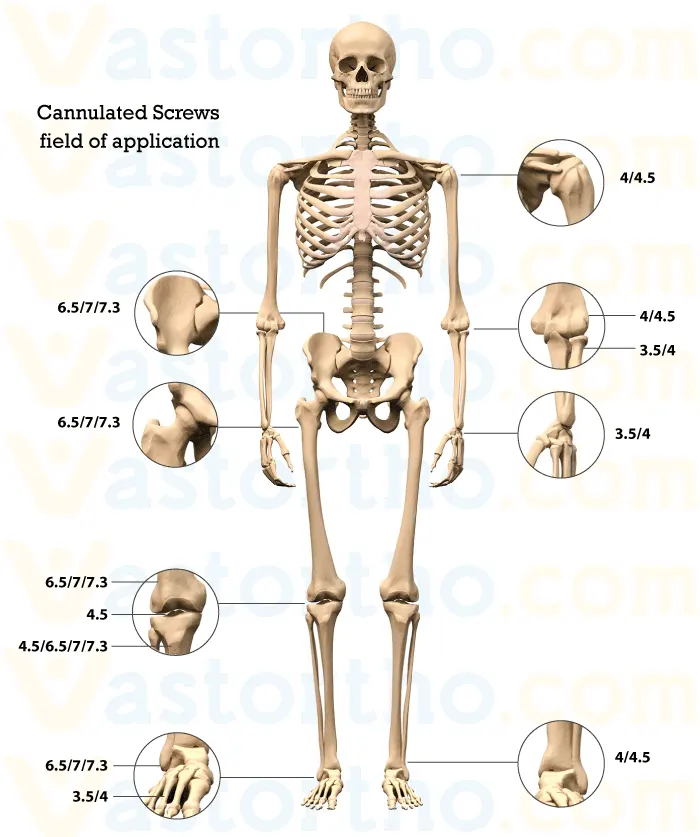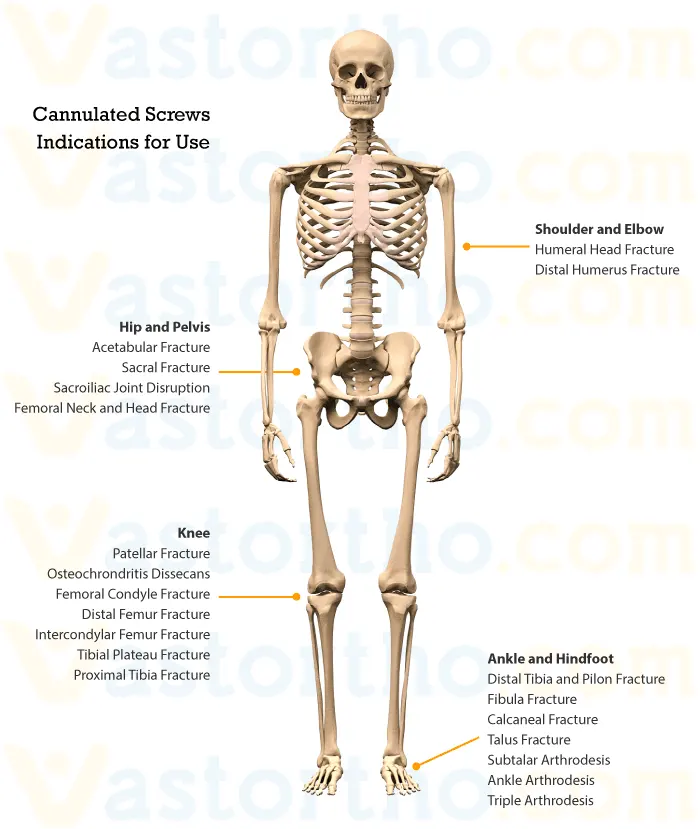Cannulated Screws Specification, Uses & Sizes
 https://www.vastortho.com/wp-content/uploads/3.5-mm-Cannulated-Screws.webp
550
1200
VastOrtho
https://www.vastortho.com/wp-content/uploads/Vast-Ortho-Logo-for-website.png
VastOrtho2017-01-10 06:59:432023-07-22 11:43:223.5 mm Cannulated Screw
https://www.vastortho.com/wp-content/uploads/3.5-mm-Cannulated-Screws.webp
550
1200
VastOrtho
https://www.vastortho.com/wp-content/uploads/Vast-Ortho-Logo-for-website.png
VastOrtho2017-01-10 06:59:432023-07-22 11:43:223.5 mm Cannulated Screw https://www.vastortho.com/wp-content/uploads/4-mm-Locking-Cannulated-Screws.webp
550
1200
VastOrtho
https://www.vastortho.com/wp-content/uploads/Vast-Ortho-Logo-for-website.png
VastOrtho2017-01-09 22:17:312023-07-22 11:47:494 mm Locking Cannulated Screw
https://www.vastortho.com/wp-content/uploads/4-mm-Locking-Cannulated-Screws.webp
550
1200
VastOrtho
https://www.vastortho.com/wp-content/uploads/Vast-Ortho-Logo-for-website.png
VastOrtho2017-01-09 22:17:312023-07-22 11:47:494 mm Locking Cannulated Screw https://www.vastortho.com/wp-content/uploads/4-mm-Cannulated-Screws.webp
550
1200
VastOrtho
https://www.vastortho.com/wp-content/uploads/Vast-Ortho-Logo-for-website.png
VastOrtho2017-01-08 06:54:212023-07-22 11:49:164 mm Cannulated Screw
https://www.vastortho.com/wp-content/uploads/4-mm-Cannulated-Screws.webp
550
1200
VastOrtho
https://www.vastortho.com/wp-content/uploads/Vast-Ortho-Logo-for-website.png
VastOrtho2017-01-08 06:54:212023-07-22 11:49:164 mm Cannulated Screw https://www.vastortho.com/wp-content/uploads/4.5-mm-Cannulated-Screws.webp
550
1200
VastOrtho
https://www.vastortho.com/wp-content/uploads/Vast-Ortho-Logo-for-website.png
VastOrtho2017-01-07 06:48:142023-07-22 11:50:254.5 mm Cannulated Screw
https://www.vastortho.com/wp-content/uploads/4.5-mm-Cannulated-Screws.webp
550
1200
VastOrtho
https://www.vastortho.com/wp-content/uploads/Vast-Ortho-Logo-for-website.png
VastOrtho2017-01-07 06:48:142023-07-22 11:50:254.5 mm Cannulated Screw https://www.vastortho.com/wp-content/uploads/5-mm-Locking-Cannulated-Screws.webp
550
1200
VastOrtho
https://www.vastortho.com/wp-content/uploads/Vast-Ortho-Logo-for-website.png
VastOrtho2017-01-06 05:33:122023-07-22 12:16:535 mm Locking Cannulated Screw
https://www.vastortho.com/wp-content/uploads/5-mm-Locking-Cannulated-Screws.webp
550
1200
VastOrtho
https://www.vastortho.com/wp-content/uploads/Vast-Ortho-Logo-for-website.png
VastOrtho2017-01-06 05:33:122023-07-22 12:16:535 mm Locking Cannulated Screw https://www.vastortho.com/wp-content/uploads/6.5-mm-Cannulated-Screws.webp
550
1200
VastOrtho
https://www.vastortho.com/wp-content/uploads/Vast-Ortho-Logo-for-website.png
VastOrtho2017-01-04 06:37:362023-07-22 12:18:006.5 mm Cannulated Screw
https://www.vastortho.com/wp-content/uploads/6.5-mm-Cannulated-Screws.webp
550
1200
VastOrtho
https://www.vastortho.com/wp-content/uploads/Vast-Ortho-Logo-for-website.png
VastOrtho2017-01-04 06:37:362023-07-22 12:18:006.5 mm Cannulated Screw https://www.vastortho.com/wp-content/uploads/7-mm-Cannulated-Screws.webp
550
1200
VastOrtho
https://www.vastortho.com/wp-content/uploads/Vast-Ortho-Logo-for-website.png
VastOrtho2017-01-03 06:21:042023-06-17 11:31:187 mm Cannulated Screw
https://www.vastortho.com/wp-content/uploads/7-mm-Cannulated-Screws.webp
550
1200
VastOrtho
https://www.vastortho.com/wp-content/uploads/Vast-Ortho-Logo-for-website.png
VastOrtho2017-01-03 06:21:042023-06-17 11:31:187 mm Cannulated Screw https://www.vastortho.com/wp-content/uploads/7.3-mm-Locking-Cannulated-Screws.webp
550
1200
VastOrtho
https://www.vastortho.com/wp-content/uploads/Vast-Ortho-Logo-for-website.png
VastOrtho2017-01-02 21:51:382023-06-17 11:31:207.3 mm Locking Cannulated Screw
https://www.vastortho.com/wp-content/uploads/7.3-mm-Locking-Cannulated-Screws.webp
550
1200
VastOrtho
https://www.vastortho.com/wp-content/uploads/Vast-Ortho-Logo-for-website.png
VastOrtho2017-01-02 21:51:382023-06-17 11:31:207.3 mm Locking Cannulated Screw https://www.vastortho.com/wp-content/uploads/7.3-mm-Cannulated-Screws.webp
550
1200
VastOrtho
https://www.vastortho.com/wp-content/uploads/Vast-Ortho-Logo-for-website.png
VastOrtho2017-01-01 06:00:402023-06-17 11:31:147.3 mm Cannulated Screw
https://www.vastortho.com/wp-content/uploads/7.3-mm-Cannulated-Screws.webp
550
1200
VastOrtho
https://www.vastortho.com/wp-content/uploads/Vast-Ortho-Logo-for-website.png
VastOrtho2017-01-01 06:00:402023-06-17 11:31:147.3 mm Cannulated Screw







